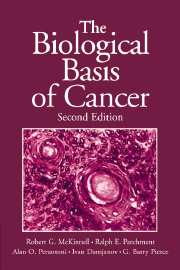Book contents
- Frontmatter
- Contents
- Preface
- Introduction: Letters illustrating clinical aspects of cancer
- 1 The pathology of cancer
- 2 Invasion and metastasis
- 3 Carcinogenesis
- 4 Genetics and heredity
- 5 Cancer-associated genes
- 6 Cancer in nonhuman organisms
- 7 Epidemiology
- 8 Lifestyle: Is there anything more important?
- 9 The stem cell basis of cancer treatment: concepts and clinical outcomes
- 10 Oncology: The difficult task of eradicating caricatures of normal tissue renewal in the human patient
- Appendix: Description of selected tumors
- Glossary
- References
- Index
- Plate section
Preface
Published online by Cambridge University Press: 05 June 2012
- Frontmatter
- Contents
- Preface
- Introduction: Letters illustrating clinical aspects of cancer
- 1 The pathology of cancer
- 2 Invasion and metastasis
- 3 Carcinogenesis
- 4 Genetics and heredity
- 5 Cancer-associated genes
- 6 Cancer in nonhuman organisms
- 7 Epidemiology
- 8 Lifestyle: Is there anything more important?
- 9 The stem cell basis of cancer treatment: concepts and clinical outcomes
- 10 Oncology: The difficult task of eradicating caricatures of normal tissue renewal in the human patient
- Appendix: Description of selected tumors
- Glossary
- References
- Index
- Plate section
Summary
This version of The Biological Basis of Cancer is referred to as a “second edition” which, of course, it is. The term “second edition” does little to inform the reader to what extent material has been updated or rewritten. Major changes were mandated throughout by the rapid pace of cancer research and the translation of new findings into improved clinical care. Be that as it may, some fundamental aspects of cancer do not change. The letters in the Introduction are such. The letters are provided to introduce the student to the impact of cancer on the lives of ordinary people and the resultant need for cancer research. That impact and need are the same today as they were several years ago and are perhaps best reflected in the remarkable cathartic writings of author John Gunther (Death Be Not Proud) on the untimely loss of his seventeen-year-old son in 1947 from a brain tumor to the recent trials and triumphs over cancer of international cycling star Lance Armstrong (It's Not About the Bike: My Journey Back to Life). Similarly, the distinction of benign versus malignant, as well as the concept of tumor grading and staging and certain other aspects of cancer discussed in the chapter on pathology remain the same. Other material has been carefully revised or rewritten – there is an entirely new Chapter 8 devoted to measures recommended by cancer organizations, and the authors of this book, to hopefully (and likely) reduce risk for cancer.
- Type
- Chapter
- Information
- The Biological Basis of Cancer , pp. xv - xviiiPublisher: Cambridge University PressPrint publication year: 2006
- 1
- Cited by



